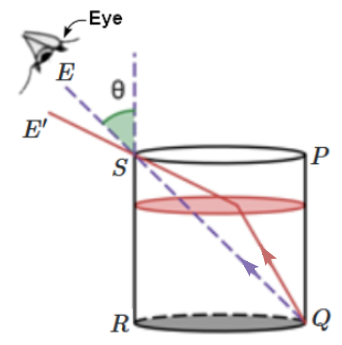Select Chapter Topics:
A ray of light passes through three parallel media, with the angles of incidence and emergence as shown in the figure. The refractive indices of the media are \(\mu_{1}\) = 1, \(\mu_{2}\) and \(\mu_{3}\).

Then:
1.
\(\mu_{2}=\frac{1}{3},~\mu_{3}=\frac{1}{2}\)
2.
\(\mu_{2}=3,~\mu_{3}=\frac{3}{2}\)
3.
\(\mu_{2}=\frac{1}{3},~\mu_{3}=\frac{2}{3}\)
4.
\(\mu_{2}=3,~\mu_{3}=2\)
Subtopic: Refraction at Plane Surface |
79%
From NCERT
Please attempt this question first.
Hints
Please attempt this question first.
A thin equi-convex lens of refractive index \(1.2\) is dipped in oil of index \(1.44.\) The lens has a power of \(2\) D (in air). When it is immersed in the oil, the focal length of the lens becomes:
1. \(50\) cm
2. \(-50\) cm
3. \(-50/1.2\) cm
4. \(-50 \times1.2\) cm
1. \(50\) cm
2. \(-50\) cm
3. \(-50/1.2\) cm
4. \(-50 \times1.2\) cm
Subtopic: Lens Makers' Formula |
58%
From NCERT
Please attempt this question first.
Hints
Please attempt this question first.
A parallel beam of width \(20\) mm is incident onto a lens and the width of the emerging beam decreases at a rate of \(1\) mm as it travels every \(3\) cm. The lens has a focal length of:
| 1. | \(30\) cm | 2. | \(60\) cm |
| 3. | \(\dfrac{20}3\) cm | 4. | \(\dfrac{40}{3}\) cm |
Subtopic: Lenses |
66%
From NCERT
Please attempt this question first.
Hints
Please attempt this question first.
A ray of light, incident at \(45^{\circ}\) onto the surface \(AB\) of the right angled prism, is reflected from \(AC\) and retraces its path backwards. The refractive index of the material of the prism is:

1. \(\sqrt2\)
2. \(2\)
3. \(2\sqrt2\)
4. \(2+\sqrt2\)

1. \(\sqrt2\)
2. \(2\)
3. \(2\sqrt2\)
4. \(2+\sqrt2\)
Subtopic: Prisms |
83%
From NCERT
Please attempt this question first.
Hints
Please attempt this question first.
An empty cylindrical beaker whose height is equal to its diameter is kept on a table. An observer's eye\((E)\) looking towards \(S\) (line of sight: \(ES\)) can see the point \(Q\) on the lower right. The angle of view, \(\theta,\) is the angle the line of sight \(ES,\) makes with the vertical \(RS\)-extended. A transparent liquid is now slowly poured into the beaker. As the liquid level rises in the beaker, the line of sight has to be continually adjusted (by increasing angle \(\theta\)) in order to keep \(Q\) visible. When the liquid fills the beaker to the brim, \(Q\) can no more be seen by adjusting the line of sight \(ES. \) The minimum refractive index of the liquid should be:

1. \(\frac32\)
2. \(2\)
3. \(\sqrt{\frac32} \)
4. \(\sqrt2\)

1. \(\frac32\)
2. \(2\)
3. \(\sqrt{\frac32} \)
4. \(\sqrt2\)
Subtopic: Total Internal Reflection |
From NCERT
Please attempt this question first.
Hints
Please attempt this question first.
A point object \((A)\) is placed on the principal axis of a convex lens (focal length = \(30\) cm) at a distance of \(45\) cm from it. The image is formed at position \(B.\) If the object \(A\) is moved up by \(1\) cm then the image moves:

1. down by \(1\) cm
2. down by \(2\) cm
3. up by \(1\) cm
4. up by \(2\) cm

1. down by \(1\) cm
2. down by \(2\) cm
3. up by \(1\) cm
4. up by \(2\) cm
Subtopic: Lenses |
62%
From NCERT
Please attempt this question first.
Hints
Please attempt this question first.
A ray of light \((1)\) gets reflected partially at the front surface of a thin film of thickness \(t,\) and refractive index \(\mu.\) The reflected ray from the front surface is \(2\) while that emerging due to reflection from the rear surface is \(3.\) Assume that ray \(1\) is incident normally. The optical path difference between rays \(2\) and \(3\) is:

1. \((\mu-1)t\)
2. \(2(\mu-1)t\)
3. \(\mu t\)
4. \(2\mu t\)

1. \((\mu-1)t\)
2. \(2(\mu-1)t\)
3. \(\mu t\)
4. \(2\mu t\)
Subtopic: Refraction at Plane Surface |
From NCERT
Please attempt this question first.
Hints
Please attempt this question first.
A ray is incident normally onto the surface \(AB\) of the prism \((\angle A=30^\circ,\angle B=90^\circ).\) The refractive index of the material of the prism is \(\sqrt2.\) The deviation of this ray is:

1. \(30^\circ\) downward
2. \(15^\circ\) downward
3. \(30^\circ\) upward
4. \(15^\circ\) upward

1. \(30^\circ\) downward
2. \(15^\circ\) downward
3. \(30^\circ\) upward
4. \(15^\circ\) upward
Subtopic: Prisms |
68%
From NCERT
Please attempt this question first.
Hints
Please attempt this question first.
A biconvex lens has radii of curvature, \(20\) cm each. If the refractive index of the material of the lens is \(1.5,\) the power of the lens is:
| 1. | infinity | 2. | \(+2\) D |
| 3. | \(+20\) D | 4. | \(+5\) D |
Subtopic: Lenses |
71%
From NCERT
NEET - 2022
To view explanation, please take trial in the course.
NEET 2025 - Target Batch
Hints
To view explanation, please take trial in the course.
NEET 2025 - Target Batch
A light ray falls on a glass surface of refractive index \(\sqrt{3}\), at an angle of \(60^\circ.\) The angle between the refracted and reflected rays would be:
| 1. | \(120^\circ\) | 2. | \(30^\circ\) |
| 3. | \(60^\circ\) | 4. | \(90^\circ\) |
Subtopic: Refraction at Plane Surface |
60%
From NCERT
NEET - 2022
To view explanation, please take trial in the course.
NEET 2025 - Target Batch
Hints
To view explanation, please take trial in the course.
NEET 2025 - Target Batch


